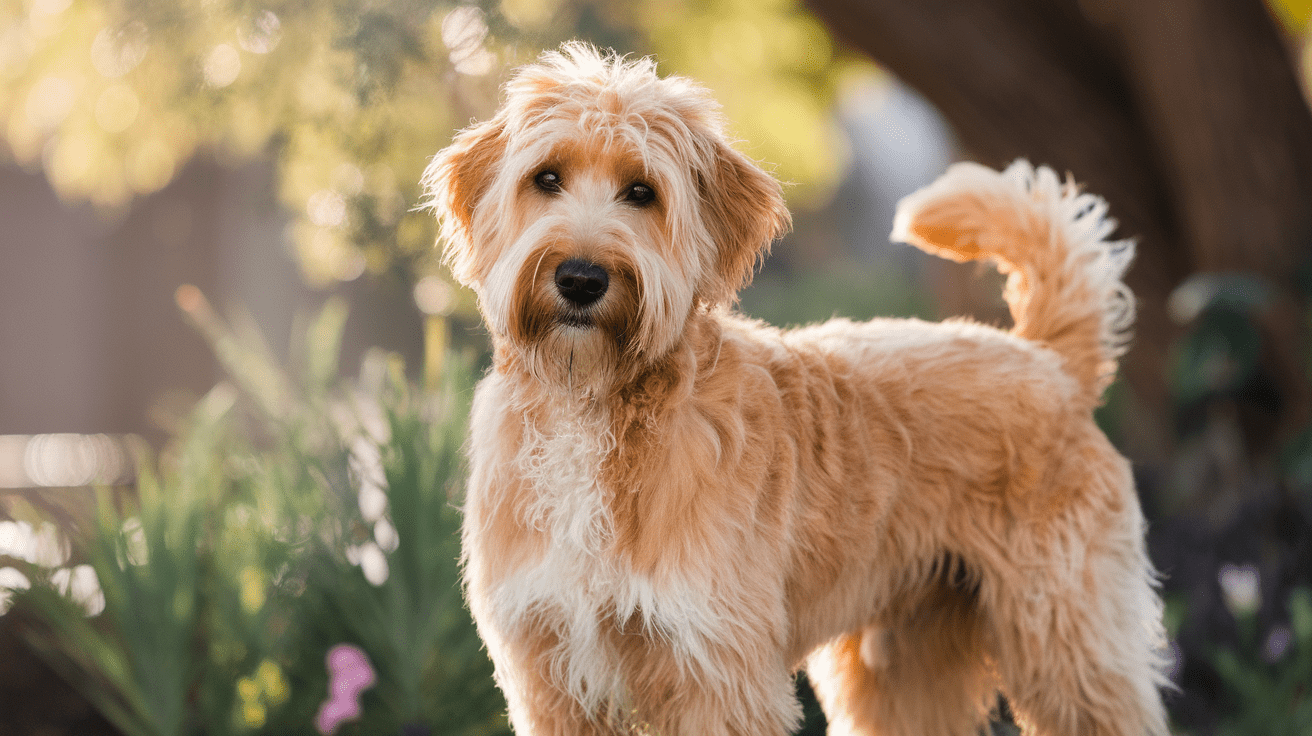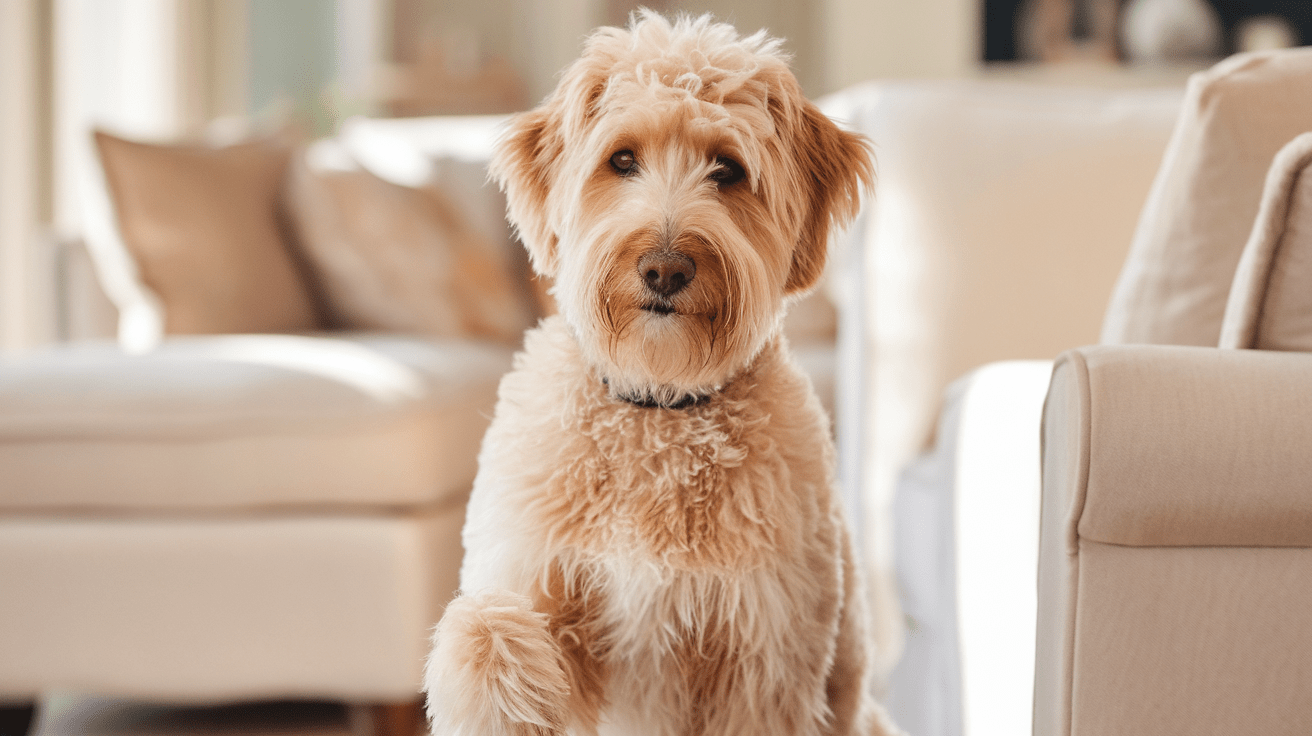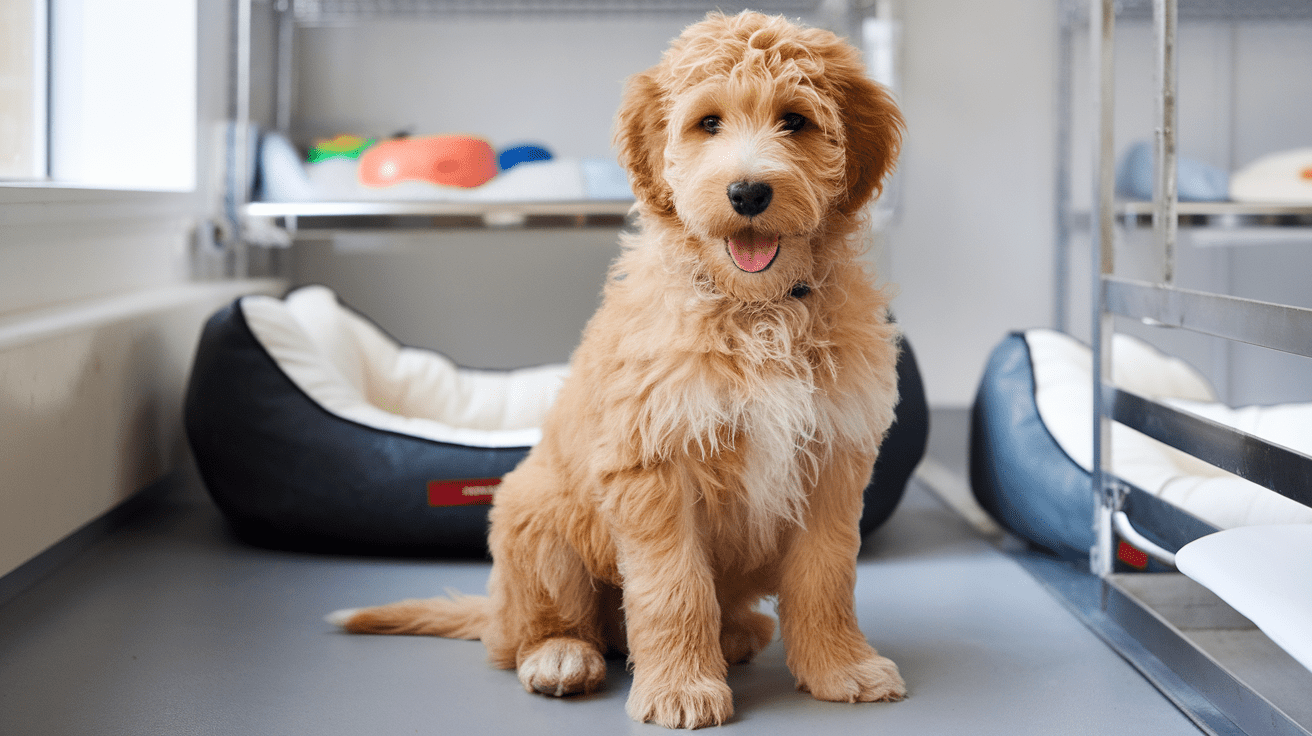Yellow Labradoodle Key Takeaways
- ✓ Breed Overview: Yellow Labradoodles are intelligent, beautiful, and low-shedding designer dogs, created by crossing Labrador Retrievers with Poodles.
- ✓ Size Options: Available in three sizes: Standard (50-65 lbs), Medium (30-45 lbs), and Miniature (15-25 lbs), suitable for different living situations.
- ✓ Care Requirements: Needs 60 minutes of daily exercise, regular grooming every 6-8 weeks, and consistent mental stimulation.
- ✓ Temperament: Highly intelligent, friendly, and people-oriented dogs that excel in family settings and various training activities.
- ✓ Investment: Expect to pay $2,500-$4,000 from reputable breeders who provide health screenings and proper documentation.
Looking for a perfect blend of intelligence, beauty, and low-shedding qualities? The Yellow Labradoodle might be your dream dog! As a veterinarian who’s treated hundreds of these golden-hued charmers, I can tell you they’re more than just adorable faces. According to the American Kennel Club, designer dogs like Labradoodles have seen a remarkable 320% increase in popularity over the past decade.
These delightful Labrador Retriever-Poodle crosses combine the best of both worlds: the Lab’s friendly nature and the Poodle’s smarts and hypoallergenic coat. Whether you’re drawn to their teddy bear appearance or searching for a family-friendly companion, understanding the unique traits of Yellow Labradoodles is crucial before bringing one home. Let’s dive into everything you need to know about these sunshine-colored canines, from their distinctive characteristics to essential care requirements.
What is a Yellow Labradoodle?

As a veterinarian who’s worked extensively with designer breeds, I can tell you that Yellow Labradoodles are the result of carefully planned crossbreeding between Labrador Retrievers and Poodles. This hybrid breed first emerged in the 1980s when Australian breeder Wally Conron sought to create a guide dog that wouldn’t trigger allergies. According to the Australian Labradoodle Association, what started as a service dog experiment has evolved into one of the most beloved designer breeds worldwide.
Yellow Labradoodles come in three distinct size variations:
• Standard: 22-24 inches tall, weighing 50-65 pounds
• Medium: 18-20 inches tall, weighing 30-45 pounds
• Miniature: 14-16 inches tall, weighing 15-25 pounds
One of the most fascinating aspects of Yellow Labradoodles is their coat variety. Think of their fur texture as a spectrum – from wool-like to fleece-like to hair-like. The wool coat feels like a sheep’s wool and is highly recommended for allergy sufferers. The fleece coat has a softer, more relaxed curl pattern, while the hair coat is straighter and more similar to a Labrador’s.
When it comes to color variations, many people confuse yellow with cream and apricot shades. Here’s a simple way to differentiate them: imagine a slice of lemon pound cake – the yellow is like pale sunshine, cream is like vanilla ice cream, and apricot has a peachy warmth to it. In my practice, I’ve noticed that true yellow Labradoodles often lighten as they age, similar to how a yellow Lab’s coat changes over time.
What makes these dogs truly special isn’t just their looks – it’s their remarkable genetic diversity. Each generation, whether F1 (first generation) or F1b (backcross), brings its own unique blend of characteristics. As someone who’s treated hundreds of these dogs, I can tell you that understanding these generational differences is crucial for predicting traits like coat type and temperament.
Yellow Labradoodle Temperament and Care

Having worked with countless Yellow Labradoodles in my veterinary practice, I can confidently say these dogs are the epitome of a perfect family companion. According to the Cornell University Canine Behavior Study, Labradoodles rank among the top 5% of breeds for adaptability and trainability, making them exceptional choices for both first-time and experienced dog owners.
Personality Traits
Yellow Labradoodles inherit an amazing blend of personality traits from their parent breeds. Think of them as the “social butterflies” of the dog world – they’re typically outgoing, friendly, and incredibly people-oriented. I often tell my clients that these dogs are like having a furry therapist at home; they seem to have a sixth sense for human emotions and provide comfort when needed.
Their intelligence is remarkable – I’ve seen these clever canines master complex commands in just a few training sessions. However, this smartness comes with a catch: they need mental stimulation to prevent boredom. One of my patients learned to open the treat cabinet within a week of arriving at his new home! This intelligence, combined with their eager-to-please nature, makes them excellent candidates for:
• Service and therapy work
• Agility training
• Advanced obedience
• Interactive puzzle games
Health and Maintenance
While generally healthy, Yellow Labradoodles can inherit certain conditions from both parent breeds. The most common health concerns I encounter in my practice include:
• Hip dysplasia
• Progressive Retinal Atrophy (PRA)
• Ear infections due to their floppy ears
• Von Willebrand’s Disease
When it comes to grooming, these dogs require dedicated maintenance. Their coats are like a garden – neglect them, and they’ll become overwhelmed with tangles and mats. I recommend professional grooming every 6-8 weeks, with regular home brushing 2-3 times per week. A daily 15-minute brushing session can become a wonderful bonding opportunity.
Exercise needs vary by size, but all Yellow Labradoodles require substantial physical activity. A minimum of 60 minutes of daily exercise is essential. This can include walks, swimming (they’re usually natural water lovers!), or fetch games. I always emphasize to my clients that a tired Labradoodle is a well-behaved Labradoodle.
Regarding diet, these active dogs need high-quality nutrition to maintain their energy levels. I’ve found they thrive on premium dog food with adequate protein (around 25-30%) and healthy fats (12-16%). Always adjust portions based on size, age, and activity level. Remember, maintaining a healthy weight is crucial – these food-motivated pups can easily overeat if given the chance!
Getting a Yellow Labradoodle

After treating numerous Labradoodles over the years, I can tell you that bringing one home requires careful consideration and research. According to the Humane Society of the United States, nearly 90% of online puppy advertisements are connected to puppy mills, making it crucial to know how to find a reputable source.
Making an Informed Decision
The cost of a Yellow Labradoodle from a reputable breeder typically ranges from $2,500 to $4,000. This price reflects:
• Health testing and genetic screening
• Early socialization and care
• Veterinary checkups and initial vaccinations
• Professional breeding expertise
I recently helped a family navigate the breeder selection process, and their experience highlights why due diligence is crucial. They initially considered a dramatically lower-priced puppy, only to discover the “breeder” had no health certifications or breeding program transparency. Remember, when it comes to designer dogs, if the price seems too good to be true, it probably is.
When selecting a breeder, look for someone who conducts these essential health screenings:
• Hip and elbow evaluations (OFA certified)
• Eye examinations (CERF certified)
• DNA tests for genetic conditions
• Heart evaluations
During your breeder visit, don’t hesitate to ask questions. Think of it like interviewing a potential childcare provider – you want to feel completely confident in their expertise and ethics. Key questions should include:
• Can I meet the parent dogs?
• What health guarantees do you offer?
• How do you socialize your puppies?
• What is your breeding philosophy?
Don’t overlook adoption as an option. While designer dogs like Labradoodles are less commonly found in shelters, specialized rescue organizations do exist. I’ve seen wonderful success stories from families who adopted adult Labradoodles. These dogs often come with the added benefits of being house-trained and having known personality traits.
Whether choosing a breeder or pursuing adoption, remember that getting a Yellow Labradoodle is a long-term commitment. Consider your lifestyle, living space, and the time you can dedicate to exercise and grooming. I always tell prospective owners to imagine their daily routine with a dog that needs both physical activity and mental stimulation – it’s a significant but incredibly rewarding responsibility.
Frequently Asked Questions About Yellow Labradoodles
Conclusion
Yellow Labradoodles are truly exceptional companions that bring together the best qualities of both Labradors and Poodles. Their intelligence, adaptability, and loving nature make them ideal for various family situations. While they require dedicated grooming and exercise commitments, the rewards of owning one far outweigh the responsibilities. As a veterinarian, I’ve witnessed countless success stories where these golden-hued dogs have transformed families’ lives with their unique blend of affection, intelligence, and loyalty. If you’re prepared for the commitment and ready to welcome a four-legged friend who combines beauty with brains, a Yellow Labradoodle might be your perfect match. Just remember to choose your breeder carefully and ensure you’re ready for the wonderful journey of Labradoodle ownership.
While we’ve covered the basics of Yellow Labradoodles here, you might be interested in exploring the full spectrum of these wonderful dogs’ coat colors. Our detailed Guide to Labradoodle Colors covers more than 20 stunning variations and patterns, from the classic cream to rare phantom markings. Understanding these color variations can help you make an informed choice when selecting your perfect Labradoodle companion, as certain colors may have different grooming requirements and fade patterns over time.




